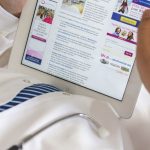
Has that week-old yogurt really gone bad? Did the chicken you bought just three days ago already spoil? Your smartphone might one day be able to tell you, new research suggests. A group of scientists is developing a portable, inexpensive and easy-to-use electronic tag to send wireless alerts to smartphones when a telltale gas is emitted by rotten food. “As we know, spoiled food can be very harmful to our health,” said study author Guihua Yu. “But sometimes we cannot easily notice the slightly degraded food by smell or vision. Therefore, we aim to develop a cost-effective wireless sensor for food spoilage detection with the assistance of mobile phones,” he explained. Yu is a professor of materials science and mechanical engineering at the University of Texas at Austin. Foodborne illnesses strike 48 million Americans each year, leading to over 128,000 hospitalizations and 3,000 deaths, according to the U.S. Centers for Disease Control and Prevention. To tackle the problem, Yu and his colleagues first put together a tiny gas sensor with a very high sensitivity to the odor-causing “biogenic amines” that are released when food goes bad. Then, the team embedded the sensors into “near-field communication” (NFC) tags, of the sort already deployed by businesses to track product shipping. The NFC sensor tags were then put through a bad meat test, because slightly spoiled meat is… read on >





































